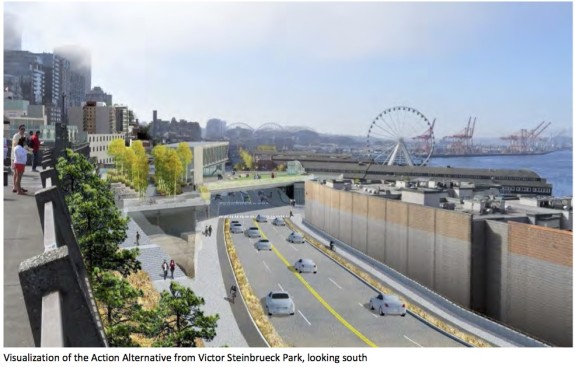 The draft Environmental Impact Statement for the redesigned Seattle downtown waterfront is out. You have until August 12 to submit comments, which you can do via this online survey or by emailing [email protected]. The final EIS should be out in late 2015 or early 2016, and construction should be ready to begin in 2017.
The draft Environmental Impact Statement for the redesigned Seattle downtown waterfront is out. You have until August 12 to submit comments, which you can do via this online survey or by emailing [email protected]. The final EIS should be out in late 2015 or early 2016, and construction should be ready to begin in 2017.
There will also be a public meeting 4:30–7:30 p.m. July 22 at City Hall.
The plan still includes a 12-foot protected bikeway on the west side of the new Alaskan Way, separated from the sidewalk, bus stops and general traffic. It also includes quality protected bike lanes on the new Elliott Way, which will climb the hill from Alaskan Way to connect to Elliott and Western Avenues. Removing the viaduct will allow for all kinds of new connections in this part of Belltown.
The roadway is still very wide with a ton of lanes to cross, especially on the south end between the ferry terminal and King Street. It’s great that most the lanes are 10 or 11 feet, since studies have shown wider lanes encourage speeding and increase collisions.
But people on foot and bikes crossing from Pioneer Square to the ferry or waterfront will still have to traverse up to 88 feet of traffic lanes. Among older populations, for example, a walking speed of 3.3 feet per second is common (PDF). At that speed, it could take nearly half a minute just to walk across all these lanes of traffic. That’s a long time to be exposed in front of traffic, and such width makes it a lot easier to get caught halfway when the lights change.
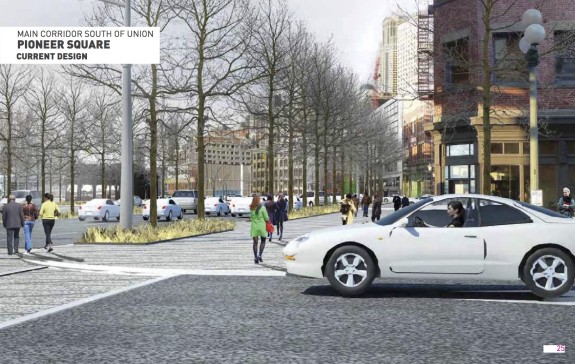
The study includes significant analysis of the motor vehicle level of service, but nearly nothing for pedestrian level of service even though it predicts more people walking across the street than vehicles driven on it during summer days.
Since walkability is clearly secondary to motor vehicle throughput goals in these designs, we referred to this previously as a surface highway to complement the tunnel highway. It might be an acceptable design if the tunnel were not being built (or if we choose to abandon the tunnel), but it’s way overbuilt as an addition to the tunnel.
Here’s an updated look at how the viaduct-free waterfront street design is shaping up:
No connection to the Elliott Bay Trail
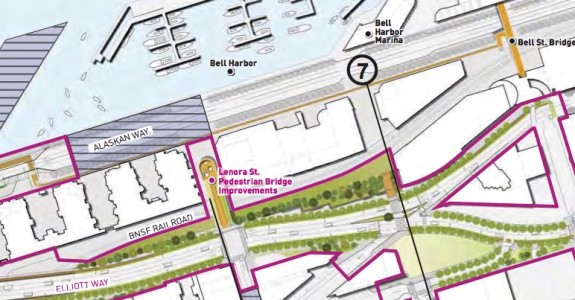 I apologize for not catching this glaring problem in my initial reporting (though it certainly wasn’t made clear in the presentations), but the planned bikeway will not actually connect to the Elliott Bay Trail. Instead, it will cross Alaskan Way at Virginia Street to connect to the existing skinny trail next to the old trolley tracks on the east side. That trail, of course, ends abruptly around Bell Street, a mere six blocks from the start of the Elliott Bay Trail.
I apologize for not catching this glaring problem in my initial reporting (though it certainly wasn’t made clear in the presentations), but the planned bikeway will not actually connect to the Elliott Bay Trail. Instead, it will cross Alaskan Way at Virginia Street to connect to the existing skinny trail next to the old trolley tracks on the east side. That trail, of course, ends abruptly around Bell Street, a mere six blocks from the start of the Elliott Bay Trail.
The primary bikeway should not cross the street. Instead, it should stay on the west side of the street and connect directly to the trail. The skinny trail on the east side of the street is fine for accessing the businesses on that side of the street, but it’s not a good primary facility.
It’s simply not acceptable that after all this work and money, we stop six blocks from actually completing the waterfront bikeway. Seattle doesn’t need another 80-percent-complete bike route. I don’t know if this change is something the state can add or if it requires a city/state partnership, but it needs to happen.
East-west connections
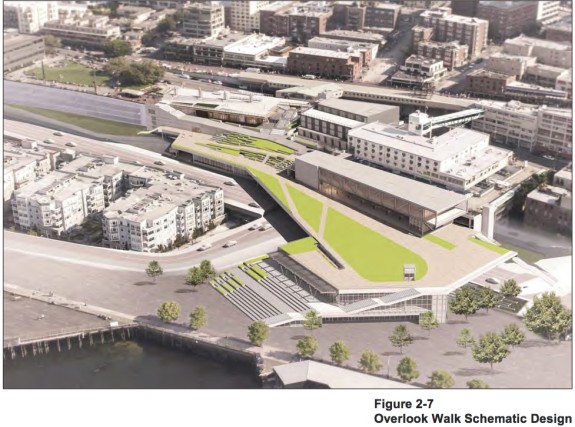
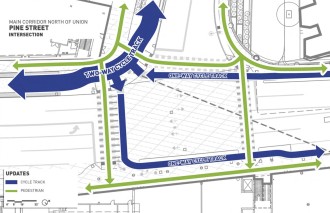 The grandest waterfront addition is the Overlook Walk between Pike Place Market and the rebuilt public space on the waterfront. This will include a ramp, but it’s not specifically being designed as a bike facility. Don’t expect this to be a high-speed bike route. It will probably (hopefully) be super crowded most the time, too.
The grandest waterfront addition is the Overlook Walk between Pike Place Market and the rebuilt public space on the waterfront. This will include a ramp, but it’s not specifically being designed as a bike facility. Don’t expect this to be a high-speed bike route. It will probably (hopefully) be super crowded most the time, too.
The protected bike lanes on the new Elliott Way will probably be the preferred bike connection from the waterfront to the market and Belltown.
The existing Bell Street Park will be extended all the way to Elliott Ave, connecting to the elevator down to Alaskan Way. It’s hard to tell from the map included above, but the new Elliott Way protected bike lanes should connect to Bell. This sets up Bell to be an awesome biking and walking connection, especially if the city can make needed changes to cut down on rampant illegal cut-through traffic and allow two-way travel, at least for people on bikes.
It that happens, all you would need is a counterflow bike lane on Bell for three blocks between 5th and 8th Avenues, and you’d have complete and safe bike connections to Dexter, the planned Westlake Bikeway and the Burke-Gilman Trail. How freaking cool would that be?
 Like the Overlook Walk, the improved Union Street connection will also not really work super well for people on bikes. There will be an elevator, but this is also primarily being designed as a walking connection. You will still be able to take University to Western, which will still have bikes lanes.
Like the Overlook Walk, the improved Union Street connection will also not really work super well for people on bikes. There will be an elevator, but this is also primarily being designed as a walking connection. You will still be able to take University to Western, which will still have bikes lanes.
Further south, Main and Washington will both be rebuilt, and the out-of-service tracks between Alaskan Way and Occidental will be removed. So these streets may become much better bike connections. It would be great to see them get some extra traffic calming to really solidify them as low-speed, low-traffic spaces. And maybe remove the rest of the rails up to 5th Ave while we’re at it?
You can dive further into the DEIS document or take the online survey here.
For more details on the ongoing design, check out these presentations from late 2014:
- Design Commission, Main Corridor South of Union, part 1 – October 16, 2014 [PDF, 51 MB]
- Design Commission, Main Corridor South of Union, part 2 – October 16, 2014 [PDF, 22 MB]
- Design Commission, North of Union – September 18, 2014 [PDF, 23 MB]

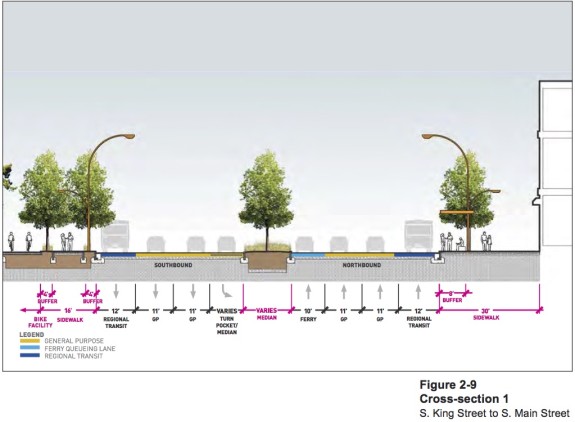
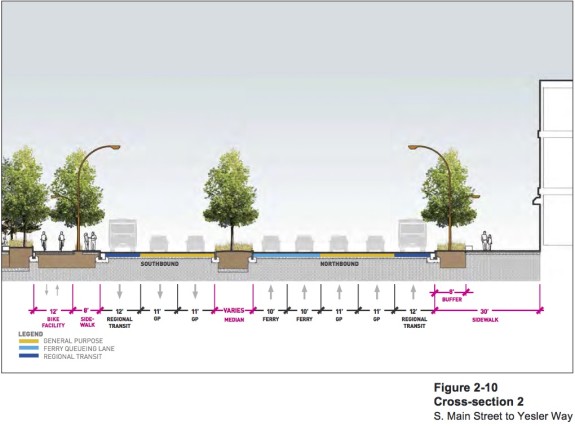
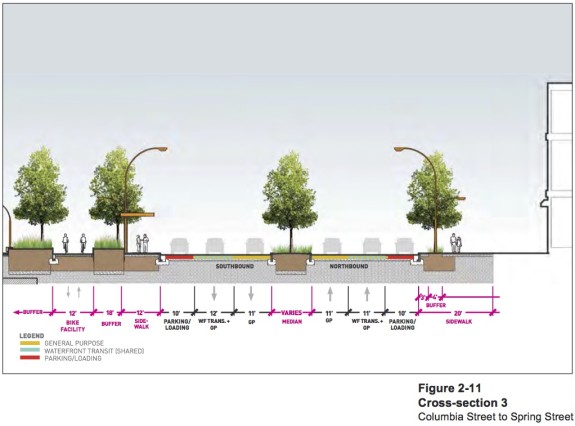
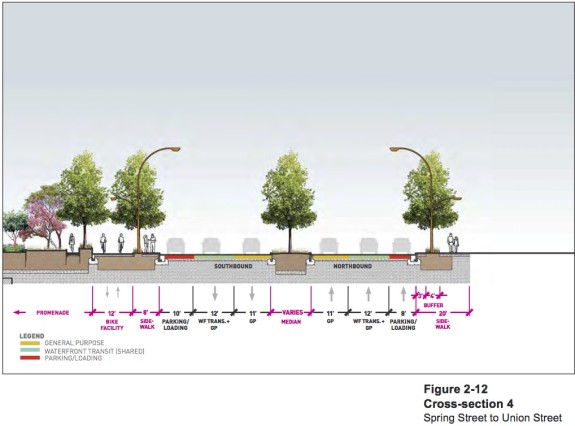
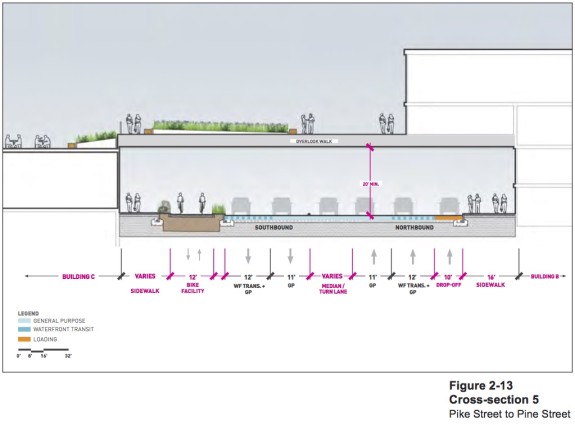
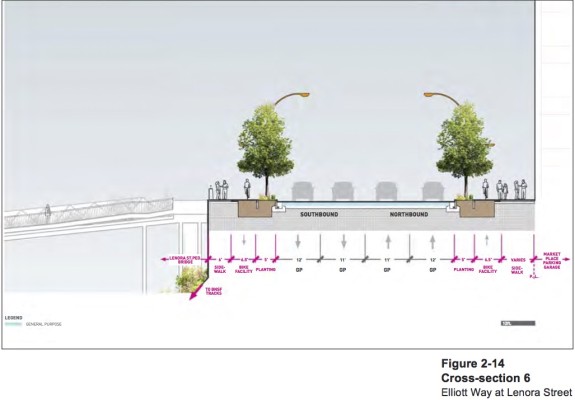
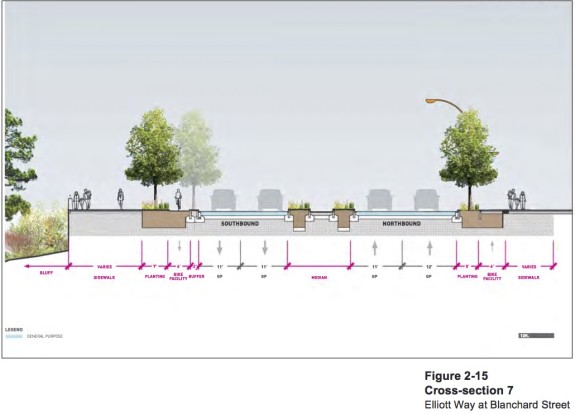







Comments
27 responses to “Our latest look at plans for a new downtown waterfront”
The Waterfront Project is on the agenda for tonight’s Seattle Bicycle Advisory Board meeting.
6pm, City Hall:
http://www.seattle.gov/Documents/Departments/SeattleBicycleAdvisoryBoard/Agendas/SBABAgenda07-01-15.pdf
Funny how I timed this post like that. Wink.
“the planned bikeway will not actually connect to the Elliott Bay Trail. ” What?…. how is that even remotely acceptable considering the amount of money being thrown at this project.
Also, when will Seattle learn to design streets that encourage safe behavior?
“Lane widths of 10 feet are appropriate in urban areas and have a positive impact on a street’s safety without impacting traffic operations.”
http://nacto.org/publication/urban-street-design-guide/street-design-elements/lane-width/
Enough with 11′ and 12′ general purpose lanes!
The bicycle master plan shows a cycle track connecting to myrtle Edwards that will be studied in 2015 (not sure when that is) and implemented in 2018. It’s probably a jurisdiction thing, where this is a WSDOT project that ends well short of connecting, but SDOT has the responsibility of the connection.
Is this a WSDOT or SDOT project? Everything on the documents states City of Seattle so it appears it’s an SDOT project? However, given most of the funding is WSDOT I’m thinking it is a WSDOT plan?
Either way another great opportunity lost and as always we will end up with great cycling infrastructure that has horrible connectivity with other great cycling infrastructure. Seems to be the Seattle way.
You say “88 feet of traffic”, but in fact it’s as much as double that, when you count all the “buffers” and medians and other dead space. These kinds of drawings always lay it on thick with the trees and shrubbery, but in real life they are concrete wastelands. If anything, this is more hostile to urban life than the viaduct is, since the viaduct at least elevates the bulk of the traffic up over people’s heads so they can walk nearly unimpeded to the waterfront. This is a stultifying city-killer. A disaster.
Is it really safe to plan that bicycle traffic on the waterfront will never outgrow a 12-foot sidepath? 12 feet would at least meet minimum standards, which is a definite step up from the plans for Westlake, but is it really enough width for safe operation on the waterfront?
CROW doesn’t include designs standards for 2-way cycletracks beyond 150 bikes/hour peak volume, but for safer one-way cycletracks over 150 bikes/hour, they call for upgrading to 8.2 feet of available lane width.
This is a route with particularly heterogeneous bike traffic, too. When a cargo bike meets a pedicab that’s stopped to pick up a tourist, is there room to pass?
If they really try to get by with just a 12-foot sidepath, many riders will stay in the street for safety and speed. I would hope SDOT could do more than the bare minimum and make a facility people would actually prefer to ride in.
If one looks at that 50+MB PDF Tom linked to: (2014_1016_Design_Commission_Main_Corridor_South_of_Union_web2_part1.pdf) , one will see that the cycle track is one giant chicane, so I don’t think they expect (or want) a whole lot of bike traffic on the cycle track, as you say: ” many riders will stay in the street for safety and speed”. Though with some (or one hell of a lot if they can’t finish the tunnel) of the traffic currently using the viaduct moving down to the surface it might not be so safe or fast, I wonder if the bus lanes will be “Bicycles OK”, or literally bus only? But it is only a %60 design, so it probably has little resemblance to what will actually be built.
As far as connecting the Elliot Bay trail, with most of the traffic heading up Elliot, I imagine traffic on the little bit of Alaskan Way at the north will be pretty light and riding in the street shouldn’t be too bad. Or one can ride the sidewalk those last few blocks, considering the 5MPH speed limit in Centennial park, anyone wanting to ride on the Elliot bay trail is probably not in a big hurry anyway. Though, actually, one can take the Thomas street bridge after riding a little ways down the Elliot bay trail and get onto Elliot Ave. and avoid Centennial park to make better time. Since Western will probably become unpleasant to ride on with some the former viaduct traffic using it, that would probably be a fair option. Tom wrote (emphasis added): “but the new Elliott Way protected bike lanes should connect to Bell”, so I’m assuming they will not continue the rest of the way on northbound Western.
The Elliot Bay Trail is a critical bike commute (and recreational) corridor. It’s the best and only reasonable way to get downtown from Magnolia and also serves Ballard bike commuters. In my experience, no one rides it at 5 mph (except maybe during Hempfest), nor should they.
My point is that it is essential that the waterfront plans anticipate heavy use by fast-moving bike commuters along the Alaskan Way corridor. This means that planners cannot simply offer as a solution the existing path on the east side of Alaskan Way between the EBT and Virginia. That path is a joke and a textbook example of how not to design a bicycle facility. The sight lines at intersections are terrible and bike/ped conflicts continual. When I commuted that section, I always used the street along with most of the other cyclists. The path was simply unacceptable. If I were still commuting there, I would be very concerned that increased car traffic volume on Alaskan Way will make the street unacceptably dangerous, leaving cyclists with a choice between a dangerous street and the dangerous and frustrating existing path.
The Draft EIS notes that bicycles will still be allowed on the street, but claims the great majority of bicycle traffic will use the path for its convenience and safety.
What’s convenient about being held down to a 12-14 mph design speed? (Judging by the illustrations, don’t have time to measure everything, but look at the number of turns, the narrow width, the number of crossings…)
What’s safe about a narrow path that doesn’t have any shy distance to concrete planters used as separation? It’s not really a 12-foot path if there’s a 2-foot-tall planter right at the edge — vertical obstructions require at least a foot of shy distance for safety (per AASHTO) so it’s really an 11-foot path, maybe 10 feet if they have obstructions on both sides.
The bicycle section of the Draft EIS simply isn’t credible, and the facility as shown does not comply with the 2014 BMP Update.
What is it going to take to stop SDOT from designing this crap? I feel like the Mayor gets it, the SDOT Director gets it, and the City Traffic Engineer gets it, but for some reason SDOT is still designing junk that’s making the same mistakes as the lost decades of American road engineering. We know they know better, but they’re still running forward with their eyes closed.
When will the madness stop?
This remains a horrible poorly designed project. Despite spending billions of the tunnel, its still a waterfront for motor vehicles, there is so much undefined empty space (despite renderings with tons of photoshopped in people), that ridiculous overbuilt pedestrian overpass from the market to the water as if this is some 1950s urban expressway with its dark cavernous streets under, unnecessary wide streets wasting land, Blanchard “Square” is nothing but channelized auto traffic like the old Times Square in NYC, Elliott Way behind the market is a surface freeway. Then greenwashing the whole thing with wild grasses perfect for encampments and shooting up (have we learned anything about public spaces in cities???) The whole thing looks like amateur hour and something that will be deemed a failure after opening and need to be redesigned but wont because of all the money spent. Its all an exercise in accommodating motor vehicle level of service and trendy landscaping to make the cover of some worthless landscape architecture rag without any sense of how people or cities work.
I can understand the traffic engineers desire to pump cars into the ferry terminal, thus creating the exhaust choking bike-pedestrian deathtrap of the area around Yesler-Marion, but the rest of the waterfront needs an all walking all biking focus. I would even trade a big parking structure for less roadway pavement. Make it all park with a serpentine two lane road for the bulk of it, make sure the hotel, the port offices, etc have good fire access, but for the love of the planet reduce the road widths, link to Myrtle Edwards, and increase bike and walking spaces!
This design would absolutely ruin what could be one of the most beautiful, inviting, and useful waterfronts in the world.
Check out the pelican that’s shown on the new Pioneer Square Beach (slide 51 of the first powerpoint). Nothing says Seattle or Puget Sound like a pelican!
The Elliott Bay trail is my lifeline to downtown, capitol hill and everywhere else south of the city. Alaskan Way is one of the only FLAT streets in this entire city–it should be a bike super highway. Additionally, it blows my mind that we are planning on creating a downtown network of PBLs when there is not one safe and reasonable way to get there from the Elliott Bay trail (don’t tell me to take the elevator). This will only become more important once we fix the Ballard Bridge and people can actually start biking downtown from there. Not connecting the waterfront to this trail renders the rest of the new bike lanes almost useless. Good luck finding a NB cyclists that’s going to cross the street onto the sidewalk (that “trail” is not for bikes no matter what a map or sign says) and then cross again to get on elliott bay. Everyone is just going to bike against traffic and inevitably someone is going to get seriously hurt. I have little faith that the new elliott way is even going to connect to Bell. It would be like if the new tunnel didn’t directly connect to the rest of 99. It’s simply unacceptable.
I missed the BAB meeting last night but they have to start putting their foot down on these connectivity issues. It’s beyond unacceptable and with each bike “improvement” they seem to be making it more dangerous to be a cyclist as the improvements almost always abruptly end at busy intersections or leave you in the wrong direction facing traffic. The lack of plans to connect to Elliott Bay is just bizarre.
I think even anti-cyclist drivers would question the logic in dumping cyclists onto the road and forcing them to cross multiple lanes of traffic so they can travel for six blocks in traffic and then cross-over again when they reach the sculpture garden. And for as much as drivers are going to hate it it will be nothing compared to the rage pedestrians are going to feel when the cyclists who opt not to play in traffic bomb down the sidewalk on the West Side. It will probably take few cyclists and children fatalities before the city understands how completely idiotic these decisions were.
This isn’t just bad and illogical for cyclists it’s bad for everyone.
Tom, can we expect an update about what happened at SBAB last night?
Yeah. Short version: They are looking into temporary bikeway connection options on the west side of Alaskan Way. The city needs to rebuild the seawall along that section, too, but that project is not yet funded. When that happens, the street will get rebuilt and a permanent bikeway can go in. So it’s on the city’s radar!
Thanks for the downloads. It helps designers picture before/after. Helped me approve median streetcar on Alaskan Way and clearing the 1st Ave median to the proposed Yesler turn west. This stretch of 1st Ave, cleared of London Plane, without a median, would probably add space for bike travel if not a painted lane. That said, north of Yesler, the 1st Ave Streetcar Connector is seriously accident prone and will likely operate ineffectively. I still say the 4th/5th Ave Couplet ‘Connector’ is the way to go.
Lastly, Bertha Plan B (ascend along seawall to Pike/Pine portal)
requires major changes to the overlook walk another substandard Seattle design. Reminds me of the basketball arena wide staircase wasted space. Yet another artificial lawn-spewn walkway posing as landscape architecture. Dark and noisy driving beneath.
If Bertha finishes as proposed, historic Seattle pioneer district buildings will not survive further destabilization of unstable soils, forcing their demolition, and in earthquake unexpected sudden building collapse is only too probable. Picture the Bore 60′ deeper, just north of Spring Street, developing a watery soil sump at least 5 blocks in length. Picture quake waves swing-banging into the bore there and picture explosive water pressure upward throughout water table channels.
This message keeps repeating til its too f’n late for Seattle and Seattlers.
From presentation at SBAB, I heard this, too:
– West side trail width is 12 feet plus 2 feet each side outside of planting areas.
– Alternate route in works for getting around the cruise ship terminal during ship embarkation periods. (and I urge SDOT/PoS to plan pedicab use to reduce the number of motor vehicles there)
– No work now at north end to EB Trail because it will all be demolished when that section of Seawall is replaced, but that section of AK Way is expected to drop from 13K vehicle trips/day to under 3K, and be “a backwater”, so travel in street is expected to be easy.
What I see is not well considered yet:
– Design for turning movements by bikes at intersections to and from upland streets to avoid conflicts with crowds of pedestrians. Needed at ALL intersections – people on bikes will not be limited to just the preferential E-W streets of the Bicycle Master Plan. Jackson, King, Yesler, Seneca, Spring, and Bell in particular. Defined bike xings and pocket queuing areas needed.
– Bike parking is not adequately considered. It will take real estate esp at ferry terminal. Personal bikes, rental bikes, bikeshare bikes, pedicab parking zones. The whole Parking section is only about motor vehicle parking. Bike parking is parking.
What looks like it will help:
– West side path has significant separation from pedestrian promenade and curbside dropoff sidewalks, with pavement and elevation distinguished from pedestrian walkways to make it look like a road for bikes, not a walk to meander onto. Huge challenge.
– The general purpose traffic signals will be timed for 25 mph, so will be a good speed for fast in-lane bike commuters when traffic permits speeds that fast.
When commenting online to the DEIS, it can be helpful to remember that this is an Environmental Impact Statement, not a design review. So, comments will be relevant if they relate to impacts to traffic (including very personal impacts to people on bikes, and for fulfilling Seattle’s Bicycle Master Plan); air pollution (including Seattle’s Climate Action Plan); water pollution; emergency and other public services.
From Freight Advisory Board meetings:
– Alaskan Way takes surface truck traffic, connecting Ballard MIC to Port and Duwamish MIC. It will be a major Metro bus route south of Columbia Street, and has lots of charter bus traffic. Heavy trucks are 10′-6″ mirror to mirror. 11 foot lane give 3 inches clear each side. Buses are about the same. Do you really want narrower lanes?
Of course the car is benefited the most. We need a low speed two lane street along the waterfront. Put a bike/ pedestrian path, that connects non motorized users safely to all the businesses and ferry terminal and eilat bay trial separate from cars. and make transit stops through out the low speed road.
Ya know, there are adjacent streets that the Port of Seattle trucks and other traffic can go down. We really should remove sections of Alaska Way and replace it with waterfront parks and plazas. This plan is lame and terrible.
[…] have shared disappointments about the planned width and channelization of Alaskan Way, including Seattle Bike Blog, any plans to further deprioritize transit on the waterfront would be both a direct bait-and-switch […]
[…] many of you submitted comments shocked by the gigantic waterfront highway presented in the most recent Waterfront Seattle plans that you triggered a requirement mandating […]
[…] of the state’s existing plans for a surface highway on the waterfront. But the city’s developing waterfront park is pretty cool and has received tons of public feedback over the course of years. These are two […]